|
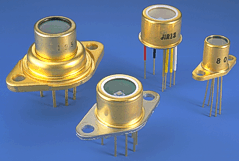
Mercury Cadmium Telluride Short Form Catalog in PDF Format
Click on any drawing on this page to
see enlarged version.
(Must have Adobe Reader to view these PDF drawings.)

J15 Series Mercury Cadium Telluride Detectors
HgCdTe is a ternary semiconductor compound which
exhibits a wavelength cutoff proportional to the alloy composition. The
actual detector is composed of a thin layer (10 to 20 µm) of HgCdTe with
metalized contact pads defining the active area. Photons with energy
greater than the semiconductor band-gap energy excite electrons into the
conduction band, thereby increasing the conductivity of the material.
The wavelength of peak response depends on the material's band-gap
energy and can easily be varied by changing the alloy composition. In
order to sense the change in conductivity, a bias current or voltage is
required. Typically, detectors are manufactured in a square or
rectangular configuration to maintain a uniform bias current
distribution throughout the active region.
Detector Bias and Operating Circuit: A basic circuit
for operating J15 Series PC HgCdTe detectors is shown in Figure 2. These
detectors are low impedance devices, typically 10 to 150 ohms, and
require a low voltage noise preamplifier. A constant bias current is
produced in the detector using a low noise DC voltage supply or battery
with a current-limiting resistor RB. An AC coupling capacitor blocks the
DC bias voltage from the high gain preamplifier and prevents DC
saturation. For optimum performance, the model PA-101 preamp is
recommended for most J15 Series detectors. The PA-101 has built-in bias
circuitry and is specially matched to each detector at the factory. The
PA-101's low noise, high gain and wide bandwidth insure proper
performance for subsequent signal processing with oscilloscopes, A-D
converters, lock-in amplifiers, etc.
|
|
|
|
|
Figure 1
|
Figure 2
|
Figure 3
|
D* and Responsivity vs. Bias: The responsivity and
detectivity of all J15 Series HgCdTe detectors are a function of bias
current. Figure 3 shows an example of relative responsivity and
detectivity for a 1mm J15D14 Series LN2 cooled detector. At low bias
currents, the responsivity increases nearly linearly with bias. At high
bias currents, self-heating of the detector eventually causes the
responsivity to fall. The point of maximum responsivity is generally not
the recommended bias for the detector. System performance depends on the
overall signal-to-noise ratio or detectivity. At low bias current the
preamplifier noise or system noise may dominate. At high bias levels the
1/f surface noise often becomes unacceptably high. Each detector is
supplied with a data sheet specifying the optimum bias current with the
PA-101 preamp. The optimum bias may vary from application to application
depending on background radiation levels.
Responsivity vs. Active Size: The voltage responsivity
of all J15 Series HgCdTe PC detectors varies significantly with the
active size of the element as shown in Fig. 4. Responsivity also depends
on cutoff wavelength, field of view restriction, operating temperature
and bias current. Responsivity for even "identical" detectors may range
over a factor of 2 due to variations in material composition. The actual
peak and blackbody responsivity data at optimum bias are supplied with
each detector. As with all photon detectors, the optimum system
performance is achieved with the smallest size detector capable of
collecting the available incident radiation. Focusing optics are highly
recommended for reducing radiation spot sizes and thereby improving
signal-to-noise performance.
|
|
|
|
|
Figure 4
|
Figure 5
|
Figure 6
|
Responsivity and Noise vs. Frequency: The frequency
response of HgCdTe detectors is related to the lifetime t of the
electrons in the HgCdTe crystal, and t depends on material composition
and operating temperature. Figure 5 is an example of responsivity and
noise vs. frequency for a J15D12 Series LN2 cooled detector. The actual
time constant for each detector type can be found in the specification
tables. The 3dB cutoff frequency fc is given by fc = (2pt) -1. All
HgCdTe PC detectors exhibit excess low frequency noise which increases
approximately as f-1/2 below a certain "corner" frequency (typically
1kHz). The optimum detectivity is achieved over a wide range from the
corner frequency up to the cutoff frequency fc. The actual responsivity,
noise and detectivity data at 10kHz are supplied with each detector.
Linearity and Temperature Effects: Each J15 Series
HgCdTe is specifically designed for a particular operating temperature
range. Responsivity and detectivity will generally increase with
decreasing temperature. HgCdTe PC detectors have a wide dynamic range
(see Fig. 7). However, a reduction in responsivity may occur at very
high incident power levels.
Applications
- Thermal Imaging
- CO2 Laser Detection
- FTIR Spectroscopy
- Missile Guidance
- Night Vision
The J15D Series detectors are Mercury Cadmium
Telluride (HgCdTe) photoconductive (PC) detectors designed for operation
in the 2 to 26 µm wavelength region. The wavelength of peak response
depends on the specific alloy composition used. All J15D Series
detectors are designed for cryogenic operation at 77°K. Judson’s
superior technology and careful device selection can provide background
limited (BLIP) detectors with state-of-the-art performance.
J15D5 Series HgCdTe PC Detectors (2 to 5 µm): The
J15D5 Series HgCdTe detectors peak at 5µm and are recommended for
thermal imaging or infrared tracking applications which require liquid
nitrogen cooled PC detectors. Excellent performance in the 3 to 5 µm
wavelength region can also be obtained from the J15TE2, J15TE3 and
J15TE4 Series thermoelectrically cooled HgCdTe detectors.
J15D12 Series HgCdTe PC Detectors (2 to 12 µm): The
J15D12 Series HgCdTe detectors peak at 11µm with a cutoff wavelength
greater than 12 µm. The devices offer optimum performance in the 8 to
12µm wavelength region with high responsivity, near-BLIP performance and
fast response time. Applications include thermography, CO2 laser
detection and missile guidance. Minimum and typical detectivities for
all standard sizes with a 60° FOV cold stop are listed in the adjoining
specification table. Cold stops for reduced FOV’s are provided for a
small additional cost and may improve detectivity since detector
performance is often background limited. Custom cold filters may also
improve detectivity by eliminating radiation in unwanted wavelength
regions. The detector is mounted in the M204 or the M205 metal dewar
with ZnSe window. A wide variety of glass and metal dewar options are
available, including dewars for Joule-Thomson cryostat and closed-cycle
cooling. The LC1 and RC2 cooler systems allow for operation of J15D12
detectors without bulk liquid nitrogen. All Judson HgCdTe PC detectors
are fully passivated and can be provided on a dewar mount or a miniature
flat pack for mounting by the customer. The J15D12 Series detectors can
be manufactured in a wide variety of special configurations including
linear arrays, quad cells and two-color sandwich devices.
J15Dxx Series HgCdTe PC Detectors for FTIR
Spectroscopy (2 to 26 µm): The J15D14, J15D16, J15D22 and J15D24 Series
HgCdTe detectors are specifically designed for use in conventional or
Fourier Transform Infrared (FTIR) Spectroscopy. The J15D14 series offers
the highest sensitivity for "narrow band" use (750 to 5000 cm-1). The 1
mm active size is recommended for conventional sampling, and the 0.1 and
0.25 mm active sizes are best for microscope applications.
The J15D16 Series offers extended wavelength coverage
for "midband" applications (600 to 5000 cm-1) while still maintaining
excellent detectivity. The J15D22 Series or J15D24 Series are the
detectors of choice for general "wide band" spectroscopy (425 to 5000
cm-1). They have much higher sensitivity and speed than alternative
pyroelectric devices. J15D Series detectors are mounted in the standard
M204 or M205 metal dewars. A variety of alternative dewars designed to
fit most FTIR manufacturers’ instruments are available as options.
Standard window materials for FTIR detectors are ZnSe for narrow band
and midband, and KRS-5 for wide band. All windows have "wedged" surfaces
to prevent unwanted interference effects. Detectivity performance data
and a spectral response curve are provided with each detector.
Click here to view table
 Click for more MCT information.
Click for more MCT information.
J15TE Series Thermoelectrically Cooled MCT Detectors
J15TE Series "Short-Wave" detectors
are photoconductive HgCdTe elements on thermoelectric coolers. They are
designed for industrial and military applications that require good
sensitivity in the 2 to 5 µm wavelength region without liquid nitrogen
cooling. J15TE Series HgCdTe detectors offer significant advantages when
compared to PbSe detectors, including high detectivity, low bias
voltage, selective peak wavelength response, and fast response times.
Applications
- Thermal Imaging
- Industrial Process Control
- Heat-Seeking Guidance
- Laser Warning Receiver
- Laser Monitoring
- Temperature Monitoring
J15TE2 Series 2-Stage Thermoelectrically Cooled HgCdTe
Detectors: J15TE2 Series detectors include a high-quality HgCdTe
element, a two-stage thermoelectric cooler, and a thermistor;
hermetically sealed in a TO-style package (66C, 3CN or HS1). The
detector cutoff and peak response wavelengths vary depending on the
selected HgCdTe material composition. Standard cutoff wavelengths for
J15TE2 Series devices are 4.0 µm, 4.5 µm and 5.0 µm.
The 2-Stage Cooler: The two-stage thermoelectric
cooler operates on low-voltage DC current to provide detector
temperatures as low as –40°C (Fig. 11). The built-in thermistor can be
used to monitor or control the detector temperature. Judson TE cooler
power supplies and temperature controllers are recommended for
convenient operation of the cooler.
J15TE3:5 Series 3-Stage Thermoelectrically Cooled
HgCdTe Detectors: J15TE3:5 Series detectors include a high-quality
HgCdTe element, a three-stage thermoelectric cooler, and a thermistor;
hermetically sealed with dry nitrogen in the flanged, "66C" package. The
detector is designed for optimum performance at 1 to 5 µm without the
expense of four-stage TE or liquid nitrogen cooling.
The 3-Stage Cooler: The three-stage thermoelectric
cooler operates on low-voltage DC current to provide detector
temperatures as low as –65°C (Fig. 12). The built-in thermistor can be
used to monitor or control the detector temperature. Judson TE cooler
power supplies and temperature controllers are recommended for
convenient operation of the cooler.
The 4-Stage Cooler: The four-stage thermoelectric
cooler operates on low-voltage DC current to provide detector
temperatures as low as –80°C (Fig. 13). The built-in thermistor can be
used to monitor or control the detector temperature. Judson TE cooler
power supplies and temperature controllers are recommended for
convenient operation of the cooler.
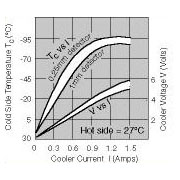
Figure 13
Thermoelectric Cooler Operation: Figures 11, 12 and 13
show typical TE2, TE3 and TE4 cooler power requirements. The Judson CM21
assembly is recommended for optimal cooling and temperature control. The
HS1 package option provides a convenient heat sink for two-stage TE
cooled detectors. Heat sinks, hybrid amplifiers and temperature
controllers for the TE coolers are also available.
Preamplifiers: The recommended preamplifiers for both
the TE2 and TE3 Series detectors are Judson's Model PA-101 and PA-300
voltage-mode preamps. The PA-101 provides constant bias current and
signal amplification for 5Hz to 1MHz operation. The PA-300 provides
constant bias voltage and signal amplification for DC to 1MHz operation.
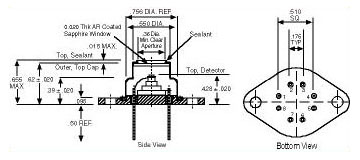
3CN Package
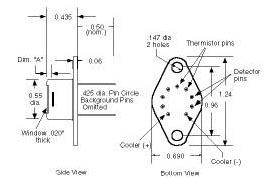
66S and 66Z Package
Click here to view table
J15TE Series "Long-Wave" detectors are photoconductive
HgCdTe elements on thermoelectric coolers for CO2 laser detection at
10.6µm or for FTIR Spectroscopy The HgCdTe detectors offer significant
advantages over alternative pyroelectric detectors, including low
microphonics, immunity to EMI, and high detectivity over a broad range
of frequencies (100Hz to 20MHz). The J15TE3:10 detectors include an
economical three-stage cooler, while the J15TE4 detectors are mounted on
high-performance four-stage coolers.
Applications
- Laser Warning Receiver
- Laser Heterodyne Detector
- Laser Monitor
- FTIR Spectroscopy
J15TE3:10 Series 3-Stage Thermoelectrically Cooled
HgCdTe Detectors: A J15TE3:10 detector includes a high-quality HgCdTe
element, a three-stage thermoelectric cooler, and a thermistor, all
hermetically sealed inside the compact 66GE package. The package is
flanged for convenient mounting on a heat sink. The detectors are
designed for economical detection of pulsed or modulated high-power CO2
lasers.
The 3-Stage Cooler: The three-stage thermoelectric
cooler operates on low-voltage DC current to provide detector
temperatures as low as –60°C. The built-in thermistor can be used to
monitor or control the detector temperature. The Judson CM21 cooler heat
sink and temperature controller is recommended for convenient operation
of the cooler.
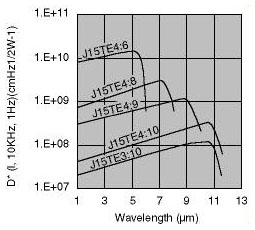
Figure 14
Preamplifiers: Judson's voltage-mode preamplifiers are
recommended for both the TE3 and TE4 Series detectors. The Judson
preamps provide detector bias as well as signal amplification. The
PA-300 preamplifier is recommended for FTIR applications and supply a
constant bias voltage to the detector.
J15TE4:10 Series 4-Stage Thermoelectrically Cooled
HgCdTe Detectors: A J15TE4:10 detector includes a high-quality HgCdTe
element, a four-stage thermoelectric cooler and a thermistor in the 3GN
hermetic package. The 3GN is a rugged package with welded seals to
insure superior hermetic integrity and long life. The detectors are
designed for pulsed or modulated CO2 laser applications at 10.6 µm where
the highest sensitivity possible without liquid nitrogen cooling is
required.
J15TE4:FTIR Series: A J15TE4:FTIR detector includes a
high quality HgCdTe element a four-stage thermoelectric cooler, and a
thermistor in the 3GN hermetic package. The detectors are designed to
give maximum signal to noise ratios for wideband FTIR applications from
1.0 µm to the cutoff wavelength specified. In combination with the CM21
assembly and a PA-300 amplifier this series gives reliable 24 hour
performance.
|
|
|
|
|
Figure 15
|
Figure 16
|
Figure 17
|
The 4-Stage Cooler: The four-stage thermoelectric
cooler operates on low-voltage DC current to provide detector
temperatures as low as 195°K (Fig. 16). The built-in thermistor can be
used to monitor or control the detector temperature. For optimum
performance, the package should be mounted on a heat sink capable of
dissipating 5 to 10 watts (Fig. 17). The Judson CM21 heat sink and
temperature controller is recommended for convenient cooler operation.
TE4 Cooler Specifications:
- Number of Stages: 4
- Cooldown Time: 30 to 150 sec
- Min. Temp. @ 25°Ambient: -90°C
- Power Required @ 6V: 3 to 7 Watts
- Ambient Temp. Range: -55 to +60°C
Click here to view J15TE Series Thermoelectrically Cooled
J15InSb Series MCT/InSb "Sandwich"
Detectors
The J15InSb Series device consists of a high quality
InSb detector mounted in a "sandwich" configuration over a HgCdTe
detector. The InSb detector responds to incident radiation from 1 to 5
µm while the HgCdTe detector responds to radiation from 6 to 13 µm (Fig.
18). Devices with response to longer wavelengths are also available.
The detector focal planes are spaced within 0.5 mm and
their centers are aligned to within 0.15 mm. The detectors operate at
77°K and are mounted in the standard M204 or M205 metal dewar with ZnSe
window. The InSb and HgCdTe elements require separate preamplifiers.
Click here to view table
 Click for more information on HgCdTe/InSb sandwich detectors.
Click for more information on HgCdTe/InSb sandwich detectors. |